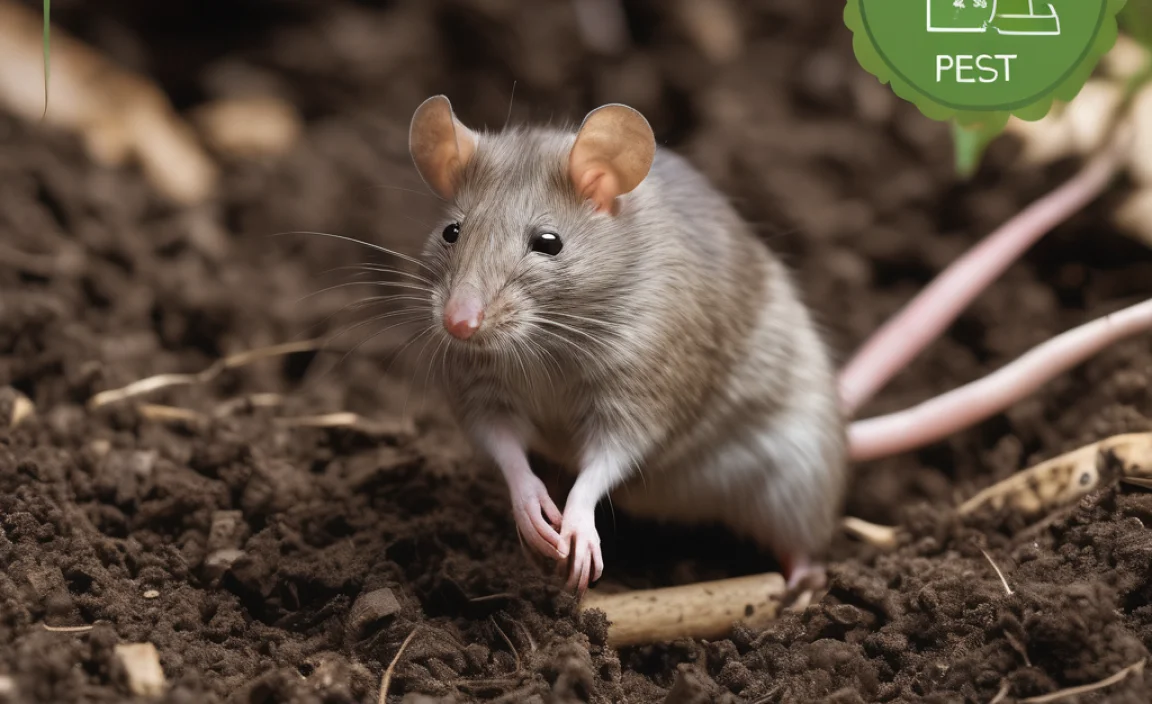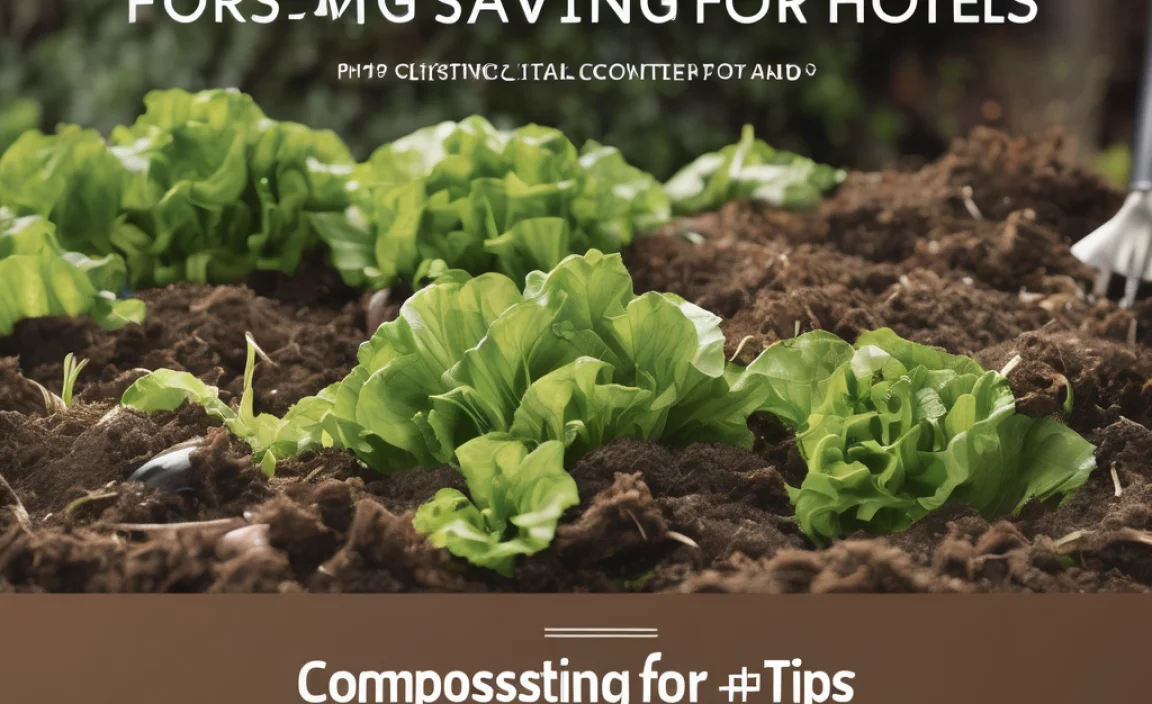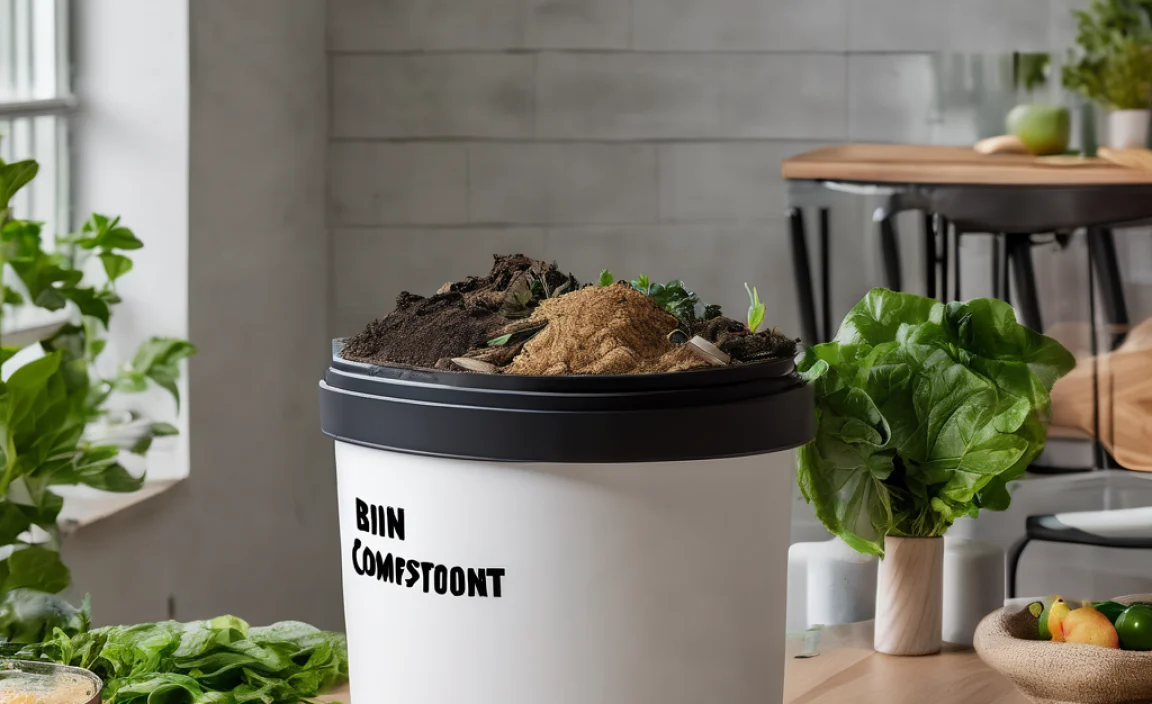Why Does Compost Get Too Acidic Anyway?
Think of compost like a healthy diet for your garden. It thrives on a good balance. When compost becomes too acidic, it means the balance has tipped. This usually happens because there’s too much “green” material and not enough “brown” material. Green materials are typically nitrogen-rich things like kitchen scraps (fruit and veggie peels, coffee grounds) and grass clippings. Brown materials are carbon-rich, like dried leaves, shredded cardboard, and straw. When greens dominate, the decomposition process can get out of whack, producing acids.
Another reason can be too much moisture. A soggy compost pile can’t breathe well. This lack of air (oxygen) encourages anaerobic decomposition, which can lead to sour smells and acidic conditions. It’s like a crowded, damp room – not ideal for healthy activity!
Signs Your Compost is Too Acidic
You might be wondering, “How do I even know if my compost is too acidic?” Good question! Here are some common signs to look out for:
- Slow Decomposition: If your compost pile isn’t breaking down materials as quickly as it should, acidity could be the culprit. Microorganisms, which are key to composting, struggle in overly acidic environments.
- Unpleasant Odor: A healthy compost pile usually smells earthy, like a forest floor after rain. If yours smells sour, vinegary, or even like ammonia, it’s a strong indicator that something’s off. This often points to too much green material and not enough air.
- Slimy or Soggy Materials: Compost that’s too wet and slimy is often a sign of poor aeration and potential acidity problems.
- Visible Mold (The Wrong Kind): While some fuzzy white mold is normal and good, dark, patchy, or stringy mold can suggest an imbalance.
- pH Testing: The most direct way to know is to test the pH. You can get inexpensive compost test kits at garden centers or online. A healthy, neutral compost pile typically has a pH between 6.0 and 7.5. Anything below 6.0 is leaning towards acidic. For more on pH and soil, the National Park Service offers a great overview.
The C-N Ratio: Your Composting Secret Weapon
Composting is all about balancing two key ingredients: carbon and nitrogen. We often refer to this as the “C-N ratio.”
Greens (Nitrogen-rich): These are materials that are typically moist and break down quickly. Think:
- Fruit and vegetable scraps
- Coffee grounds and tea bags
- Grass clippings
- Plant trimmings (fresh)
- Manure (from herbivores like cows or chickens)
Browns (Carbon-rich): These are usually dry and provide structure and aeration. Think:
- Dried leaves
- Shredded newspaper and cardboard (non-glossy)
- Straw and hay
- Small twigs and wood chips
- Sawdust (from untreated wood)
For good composting, you want roughly a 25:1 to 30:1 ratio of carbon to nitrogen by weight. In simpler terms, this often means aiming for about two to three times more brown material than green material by volume. When your compost becomes too acidic, it’s usually a sign that you’ve thrown in too many greens compared to browns.
Essential Fixes for Acidic Compost
Don’t worry if your compost has gone a little sour. There are straightforward ways to bring it back into balance. These fixes are all about adjustments, not starting over.
1. Add More “Browns”
This is your primary fix. If your compost is too acidic, you likely have too much nitrogen (greens). The solution is to introduce more carbon-rich brown materials. This helps rebalance the C-N ratio and provides food for the microbes that like a less acidic environment.
How to do it:
- Go on a scavenger hunt for dry leaves, shredded cardboard, or straw.
- Loosen up your compost pile with a pitchfork or shovel.
- Layer in a good amount of your collected browns. Aim to add enough to significantly increase the volume of browns compared to the greens you’ve been seeing.
- Mix them in thoroughly. You want those browns to get mixed in with the existing materials so they can start breaking down and absorbing excess moisture and acidity.
2. Improve Aeration (Let It Breathe!)
As we mentioned, a lack of oxygen can lead to anaerobic conditions, which can produce acids. Turning your compost pile regularly is crucial for allowing air to circulate. This also helps the materials decompose evenly.
How to do it:
- Use a pitchfork or a compost aerator tool.
- Dig deep into the pile and turn the materials over, moving outer layers to the center and inner layers to the outside.
- Aim to turn your compost pile at least once a week, or more frequently if it seems very wet or compacted.
- If you have a large pile, consider using a compost tumbler. These make turning much easier and ensure good air flow.
3. Watch the Moisture Level
Too much water can make your compost soggy and acidic. While compost needs to be moist, it shouldn’t be soaking wet. It should feel like a wrung-out sponge.
How to do it:
- If your pile is too wet, add more dry brown materials (like shredded cardboard or leaves). They’ll act like sponges, soaking up excess moisture.
- Ensure your compost bin has adequate drainage. If it’s sitting in a puddle, move it or add a layer of coarse material (like small branches) at the bottom.
- Cover your compost pile during heavy rains, especially if it’s already quite wet. Use a tarp or a piece of plywood.
4. Add Alkaline Materials (Lime or Wood Ash)
This is a more direct way to neutralize acidity. You can add materials that are alkaline (the opposite of acidic) to help raise the pH of your compost.
Option A: Garden Lime
- Use agricultural lime (dolomitic or calcitic lime). Avoid hydrated lime, as it’s too harsh.
- Sprinkle a small amount of lime over the compost layers as you build your pile or when you turn it.
- Important Note: Don’t overdo it! Too much lime can make your compost too alkaline, which is also bad for decomposition. A light dusting is usually sufficient.
Option B: Wood Ash
- This comes from burning natural, untreated wood.
- Wood ash is alkaline and can help raise the pH.
- Like lime, use it sparingly. Sprinkle a thin layer over the compost.
- Caution: Never use ash from charcoal briquettes, treated wood, or painted/varnished wood, as these can contain harmful chemicals.
When to Use Lime or Wood Ash: It’s best to use these only if you’ve tested your compost and confirmed it’s significantly acidic, or if you’re consistently having trouble with very sour-smelling compost despite adding browns and turning. Often, balancing the greens and browns and ensuring good aeration is enough.
5. Check What You’re Adding
Sometimes, the culprits are specific items you might be adding. Certain kitchen scraps are naturally more acidic.
- Citrus Peels: While they will eventually break down, a large amount of citrus peels can temporarily lower the pH. If you have a lot of them, try to balance them with plenty of brown materials.
- Tomatoes and Other Acidic Foods: Similar to citrus, consistently adding large quantities of acidic food scraps can tip the balance.
- Coffee Grounds: While generally great for compost, coffee grounds are slightly acidic. If you’re a heavy coffee drinker and add a lot of grounds, be sure to balance them with more browns to compensate.
Tip: If you’re adding a lot of these items, make sure to bury them within the pile and mix them well with carbon-rich materials to help buffer their acidity.
Understanding pH and Compost Health: A Quick Look
The pH scale measures how acidic or alkaline something is. A pH of 7 is neutral. Anything below 7 is acidic, and anything above 7 is alkaline. For composting, we’re aiming for the sweet spot, which is generally between 6.0 and 7.5. At this pH, the vast majority of beneficial composting microbes thrive.
Here’s a simple breakdown:
| pH Level | Description | Impact on Compost |
|---|---|---|
| Below 5.5 | Strongly Acidic | Slow decomposition, potential sour odor, unfavorable for most beneficial microbes. |
| 5.5 – 6.5 | Moderately Acidic | Decomposition may be slow. Some beneficial microbes can still work, but populations might be reduced. |
| 6.5 – 7.5 | Neutral to Slightly Acidic/Alkaline | Ideal range for most composting microorganisms. Fast and efficient decomposition. Earthy smell. |
| Above 7.5 | Moderately Alkaline | Decomposition can slow down again, and some beneficial bacteria may struggle. Ammonia smell can occur. |
| Above 8.5 | Strongly Alkaline | Very slow decomposition, potential ammonia smell. Unfavorable for many beneficial microbes. |
Why pH Matters for Gardeners Using Compost
Even if your compost isn’t overly acidic, understanding its pH is important for your garden. Adding compost that is too acidic to your garden soil can lower the soil’s pH, potentially harming sensitive plants. Conversely, overly alkaline compost can raise soil pH. Healthy soil pH is crucial for plants to absorb nutrients. For a deeper dive into soil health, the Environmental Protection Agency shares resources on soil health.
Troubleshooting Common Composting Issues
It’s not just acidity that can throw a wrench in your composting plans. Let’s touch on a couple of other common problems and how they relate:
Problem: The Pile Smells Like Ammonia
This usually means there’s too much nitrogen (greens) and not enough carbon (browns). It’s the opposite problem to acidity but has a similar root cause – an imbalance in greens and browns. The excess nitrogen is released as ammonia gas.
Fix: Add plenty of brown materials (leaves, cardboard, straw) and turn the pile to aerate it. This helps to balance the nitrogen and allows the ammonia gas to dissipate.
Problem: The Pile Isn’t Heating Up
A hot compost pile indicates that the microorganisms are working hard. If your pile is cold, decomposition might be too slow.
Possible Causes:
- Too Dry: Microbes need moisture.
- Not Enough Nitrogen: Greens provide the food for microbes.
- Too Much Volume: A pile needs a certain mass to generate heat.
- Poor Aeration: The pile might be too compacted.
Fixes depend on the cause: Add water if dry, add greens if lacking nitrogen, add more materials if too small, or turn if too compacted.
These issues often go hand-in-hand. A pile that smells sour might also be too wet or not heating up effectively. By addressing the balance and aeration, you’ll often solve multiple problems at once.
Preventing Acidic Compost in the Future
The best way to deal with acidic compost is to avoid it in the first place! Here are some proactive tips:
- Maintain the Green-to-Brown Balance: This is number one. Visually aim for more browns than greens in your compost bin.
- Chop Materials Smaller: Smaller pieces break down faster and can be mixed more thoroughly, leading to better aeration and quicker composting.
- Turn Regularly: Make turning a habit. It keeps air flowing and helps everything break down evenly.
- Monitor Moisture: Keep your compost pile consistently moist but not waterlogged.
- Test Periodically: Use a pH test kit every few months to catch issues before they become big problems.
- Avoid Overloading with Certain Items: If you have a lot of coffee grounds or citrus peels, make sure to balance them out with an equal or greater amount of brown materials.
Conclusion
Dealing with compost that’s too acidic can feel like a setback, but it’s a perfectly fixable part of the composting journey. By understanding the balance of “greens” and “browns,” ensuring good aeration, and monitoring moisture, you’re well on your way to creating superb compost. Remember to add more carbon-rich materials, turn your pile regularly, and adjust moisture as needed. If things are still off, a little bit of lime or wood ash can help nudge the pH back into the ideal range. Don’t be discouraged; each composting cycle is a learning experience. In no time, your compost will be the rich, balanced, and beneficial boost your garden needs!
Frequently Asked Questions About Acidic Compost
How do I know if my compost is too acidic?
You might notice slow decomposition, a sour or vinegary smell, or materials that look slimy. The most reliable way is to use a compost pH test kit, available at garden stores or online. A pH below 6.0 is generally considered acidic.
What is the ideal pH for compost?
The ideal pH range for compost is between 6.0 and 7.5. This zone is considered neutral to slightly acidic and is perfect for the diverse communities of microorganisms that break down organic matter efficiently.
Can I fix acidic compost without buying anything?
Yes! Often, the best fixes involve materials you likely already have. Adding more carbon-rich “brown” materials like dried leaves, shredded cardboard, or straw is the primary way to rebalance the C-N ratio. Regularly turning and aerating the pile also helps immensely.
How much lime or wood ash should I add?
Use lime or wood ash sparingly. A light dusting is usually enough. It’s best to add them when you notice consistently acidic conditions or if your pH test shows a very low reading. Over-adding can make the compost too alkaline.
Is it bad to put a lot of coffee grounds in my compost?
Coffee grounds are slightly acidic. While they are great for compost in moderation, putting in a very large quantity without balancing them with enough brown materials can contribute to increased acidity. Try to mix them well with shredded paper or dried leaves.
What happens if I use too acidic compost on my garden?
Applying overly acidic compost to your garden can lower the soil’s pH. This can make it difficult for plants to absorb essential nutrients, leading to stunted growth, yellowing leaves, and reduced flowering or fruiting. Some plants, like blueberries or azaleas, prefer acidic soil, but most common garden plants do best in a more neutral range.
How long does it take to fix acidic compost?
With consistent effort in adding browns, turning, and managing moisture, you can often see improvements in your compost pile within a few weeks to a couple of months. The speed depends on the severity of the acidity, the size of your pile, and how diligently you apply the fixes.

I am passionate about home engineering. I specialize in designing, installing, and maintaining heating, ventilation, and air conditioning systems. My goal is to help people stay comfortable in their homes all year long.



